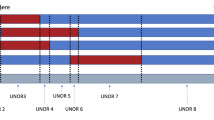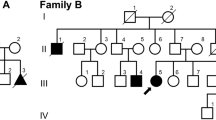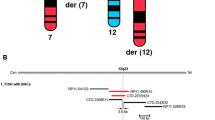Abstract
To clarify the genotype–phenotype correlation of 5p- syndrome, FISH analyses were performed for six patients by using a series of probes spanning 5p13.1–p15.33. Genotypically, break points of deletion were quite different. Three of the six patients were diagnosed as interstitial deletion on chromosome 5p by G-banding method and FISH analysis; however, all of them proved to be entire distal deletions of 5p caused by unbalanced chromosomal translocations. Furthermore, one 5p- syndrome patient was diagnosed only by the FISH analysis using a single probe but not by ordinary chromosomal analyses. Therefore, when ordinary chromosomal analysis cannot detect any deletion in a patient who is phenotypically suspected of 5p- syndrome, multiple FISH analysis or parental chromosomal analysis would be needed for correct diagnosis. Interestingly, one patient with terminal deletion between 5p15.31-pter lacks mental retardation and cat-like crying, indicating that this region might not be responsible for those cardinal features of 5p- syndrome. Further studies on genotype–phenotype correlation will help us better understand 5p- syndrome and also determine functional mapping of the 5p region.
Similar content being viewed by others
Log in or create a free account to read this content
Gain free access to this article, as well as selected content from this journal and more on nature.com
or
References
Church DM, Yang J, Bocian M, Shiang R, Wasmuth JJ (1997) A high-resolution physical and transcript map of cri du chat region of human chromosome 5p. Genome Res 7:787–801
Gersh M, Goodart SA, Pasztor LM, Harris DJ, Weiss L, Overhauser J (1995) Evidence for a distinct region causing a cat-like cry in patients with 5p deletions. Am J Hum Genet 56:1404–1410
Mainardi PC, Perfumo C, Cali A, Coucourde G, Pastore G, Cavani S, Zara F, Overhauser J, Pierluigi M, Bricarelli FD (2001) Clinical and molecular characterisation of 80 patients with 5p deletion: genotype–phenotype correlation. J Med Genet 38:151–158
Medina M, Marinescu RC, Overhauser J, Kosik KS (2000) Hemizygosity of delta- catenin (CTNND2) is associated with severe mental retardation in cri-du-chat syndrome. Genomics 63:157–164
Shimokawa O, Kurosawa K, Ida T, .Harada N, Kondoh T, Miyake N, Yoshiura K, Kishino T, Ohta T, Niikawa N, Matsumoto N (2004) Molecular characterization of inv dup del(8p): analysis of five cases. Am J Med Genet 128A:133–137
Zhang A, Zheng C, Hou M, Lindvall C, Ki KJ, Erlandsson F, Bjorkholm M, Gruber A, Blennow E, Xu D (2003) Deletion of the telomerase reverse transcriptase gene and haploinsufficiency of telomere maintenance in Cri du chat syndrome. Am J Hum Genet 72:940–948
Author information
Authors and Affiliations
Corresponding author
Rights and permissions
About this article
Cite this article
Kondoh, T., Shimokawa, O., Harada, N. et al. Genotype-phenotype correlation of 5p- syndrome: pitfall of diagnosis. J Hum Genet 50, 26–29 (2005). https://doi.org/10.1007/s10038-004-0213-9
Received:
Accepted:
Published:
Issue date:
DOI: https://doi.org/10.1007/s10038-004-0213-9
Keywords
This article is cited by
-
Prenatal diagnosis of cri-du-chat syndrome by SNP array: report of twelve cases and review of the literature
Molecular Cytogenetics (2019)
-
A cryptic balanced translocation (5;17), a puzzle revealed through a critical evaluation of the pedigree and a FISH focused on candidate loci suggested by the phenotype
Molecular Cytogenetics (2015)
-
Use of Multiplex Ligation-Dependent Probe Amplification (MLPA) in screening of subtelomeric regions in children with idiopathic mental retardation
The Indian Journal of Pediatrics (2009)
-
Cri du Chat syndrome
Orphanet Journal of Rare Diseases (2006)



